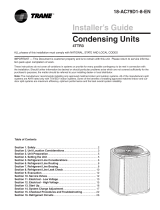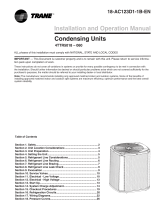
©2023 Trane 18-BC89D1-1M-EN
SAFETY SECTION — OUTDOOR
IImmppoorrttaanntt — This document contains a wiring diagram
and service information. This is customer property and
is to remain with this unit. Please return to service
information pack upon completion of work.
WWAARRNNIINNGG
HHAAZZAARRDDOOUUSS VVOOLLTTAAGGEE!!
FFaaiilluurree ttoo ffoollllooww tthhiiss WWaarrnniinngg ccoouulldd rreessuulltt iinn
pprrooppeerrttyy ddaammaaggee,, sseevveerree ppeerrssoonnaall iinnjjuurryy,, oorr
ddeeaatthh..
DDiissccoonnnneecctt aallll eelleeccttrriicc ppoowweerr,, iinncclluuddiinngg rreemmoottee
ddiissccoonnnneeccttss bbeeffoorree sseerrvviicciinngg.. FFoollllooww pprrooppeerr
lloocckkoouutt//ttaaggoouutt pprroocceedduurreess ttoo eennssuurree tthhee ppoowweerr
ccaannnnoott bbee iinnaaddvveerrtteennttllyy eenneerrggiizzeedd..
WWAARRNNIINNGG
RREEFFRRIIGGEERRAANNTT OOIILL!!
AAnnyy aatttteemmpptt ttoo rreeppaaiirr aa cceennttrraall aaiirr ccoonnddiittiioonniinngg
pprroodduucctt mmaayy rreessuulltt iinn pprrooppeerrttyy ddaammaaggee,, sseevveerree
ppeerrssoonnaall iinnjjuurryy,, oorr ddeeaatthh..
TThheessee uunniittss uussee RR--441100AA rreeffrriiggeerraanntt wwhhiicchh ooppeerraatteess
aatt 5500 ttoo 7700%% hhiigghheerr pprreessssuurreess tthhaann RR--2222.. UUssee oonnllyy
RR--441100AA aapppprroovveedd sseerrvviiccee eeqquuiippmmeenntt.. RReeffrriiggeerraanntt
ccyylliinnddeerrss aarree ppaaiinntteedd aa ““RRoossee”” ccoolloorr ttoo iinnddiiccaattee
tthhee ttyyppee ooff rreeffrriiggeerraanntt aanndd mmaayy ccoonnttaaiinn aa ““ddiipp””
ttuubbee ttoo aallllooww ffoorr cchhaarrggiinngg ooff lliiqquuiidd rreeffrriiggeerraanntt iinnttoo
tthhee ssyysstteemm.. AAllll RR--441100AA ssyysstteemmss wwiitthh vvaarriiaabbllee
ssppeeeedd ccoommpprreessssoorrss uussee aa PPVVEE ooiill tthhaatt rreeaaddiillyy
aabbssoorrbbss mmooiissttuurree ffrroomm tthhee aattmmoosspphheerree.. TToo lliimmiitt
tthhiiss ““hhyyggrroossccooppiicc”” aaccttiioonn,, tthhee ssyysstteemm sshhoouulldd
rreemmaaiinn sseeaalleedd wwhheenneevveerr ppoossssiibbllee.. IIff aa ssyysstteemm hhaass
bbeeeenn ooppeenn ttoo tthhee aattmmoosspphheerree ffoorr mmoorree tthhaann 44
hhoouurrss,, tthhee ccoommpprreessssoorr ooiill mmuusstt bbee rreeppllaacceedd.. NNeevveerr
bbrreeaakk aa vvaaccuuuumm wwiitthh aaiirr aanndd aallwwaayyss cchhaannggee tthhee
ddrriieerrss wwhheenn ooppeenniinngg tthhee ssyysstteemm ffoorr ccoommppoonneenntt
rreeppllaacceemmeenntt..
CCAAUUTTIIOONN
HHOOTT SSUURRFFAACCEE!!
MMaayy ccaauussee mmiinnoorr ttoo sseevveerree bbuurrnniinngg.. FFaaiilluurree ttoo
ffoollllooww tthhiiss CCaauuttiioonn ccoouulldd rreessuulltt iinn pprrooppeerrttyy
ddaammaaggee oorr ppeerrssoonnaall iinnjjuurryy..
DDoo nnoott ttoouucchh ttoopp ooff ccoommpprreessssoorr..
CCAAUUTTIIOONN
CCOONNTTAAIINNSS RREEFFRRIIGGEERRAANNTT!!
FFaaiilluurree ttoo ffoollllooww pprrooppeerr pprroocceedduurreess ccaann rreessuulltt iinn
ppeerrssoonnaall iillllnneessss oorr iinnjjuurryy oorr sseevveerree eeqquuiippmmeenntt
ddaammaaggee..
SSyysstteemm ccoonnttaaiinnss ooiill aanndd rreeffrriiggeerraanntt uunnddeerr hhiigghh
pprreessssuurree.. RReeccoovveerr rreeffrriiggeerraanntt ttoo rreelliieevvee pprreessssuurree
bbeeffoorree ooppeenniinngg ssyysstteemm..
CCAAUUTTIIOONN
GGRROOUUNNDDIINNGG RREEQQUUIIRREEDD!!
FFaaiilluurree ttoo iinnssppeecctt oorr uussee pprrooppeerr sseerrvviiccee ttoooollss mmaayy
rreessuulltt iinn eeqquuiippmmeenntt ddaammaaggee oorr ppeerrssoonnaall iinnjjuurryy..
RReeccoonnnneecctt aallll ggrroouunnddiinngg ddeevviicceess.. AAllll ppaarrttss ooff tthhiiss
pprroodduucctt tthhaatt aarree ccaappaabbllee ooff ccoonndduuccttiinngg eelleeccttrriiccaall
ccuurrrreenntt aarree ggrroouunnddeedd.. IIff ggrroouunnddiinngg wwiirreess,, ssccrreewwss,,
ssttrraappss,, cclliippss,, nnuuttss,, oorr wwaasshheerrss uusseedd ttoo ccoommpplleettee aa
ppaatthh ttoo ggrroouunndd aarree rreemmoovveedd ffoorr sseerrvviiccee,, tthheeyy mmuusstt
bbee rreettuurrnneedd ttoo tthheeiirr oorriiggiinnaall ppoossiittiioonn aanndd pprrooppeerrllyy
ffaasstteenneedd..
WWAARRNNIINNGG
SSEERRVVIICCEE VVAALLVVEESS!!
FFaaiilluurree ttoo ffoollllooww tthhiiss wwaarrnniinngg wwiillll rreessuulltt iinn aabbrruupptt
rreelleeaassee ooff ssyysstteemm cchhaarrggee aanndd mmaayy rreessuulltt iinn
ppeerrssoonnaall iinnjjuurryy aanndd//oorr pprrooppeerrttyy ddaammaaggee..
EExxttrreemmee ccaauuttiioonn sshhoouulldd bbee eexxeerrcciisseedd wwhheenn
ooppeenniinngg tthhee SSuuccttiioonn aanndd LLiiqquuiidd LLiinnee SSeerrvviiccee VVaallvvee..
TTuurrnn vvaallvvee sstteemm ccoouunntteerrcclloocckkwwiissee oonnllyy uunnttiill tthhee
sstteemm ccoonnttaaccttss tthhee rroolllleedd eeddggee.. NNoo ttoorrqquuee iiss
rreeqquuiirreedd..
WWAARRNNIINNGG
BBRRAAZZIINNGG RREEQQUUIIRREEDD –– IIFF UUSSIINNGG
MMEECCHHAANNIICCAALL CCOONNNNEECCTTIIOONNSS,,
EENNSSUURREE LLEEAAKK TTEESSTT IISS NNEEGGAATTIIVVEE!!
FFaaiilluurree ttoo iinnssppeecctt lliinneess oorr uussee pprrooppeerr sseerrvviiccee ttoooollss
mmaayy rreessuulltt iinn eeqquuiippmmeenntt ddaammaaggee oorr ppeerrssoonnaall
iinnjjuurryy..
IIff uussiinngg eexxiissttiinngg rreeffrriiggeerraanntt lliinneess mmaakkee cceerrttaaiinn tthhaatt
aallll jjooiinnttss aarree bbrraazzeedd,, nnoott ssoollddeerreedd..
WWAARRNNIINNGG
HHIIGGHH LLEEAAKKAAGGEE CCUURRRREENNTT!!
FFaaiilluurree ttoo ffoollllooww tthhiiss WWaarrnniinngg ccoouulldd rreessuulltt iinn
pprrooppeerrttyy ddaammaaggee,, sseevveerree ppeerrssoonnaall iinnjjuurryy,, oorr
ddeeaatthh..
EEaarrtthh ccoonnnneeccttiioonn eesssseennttiiaall bbeeffoorree ccoonnnneeccttiinngg
eelleeccttrriiccaall ssuuppppllyy..






















